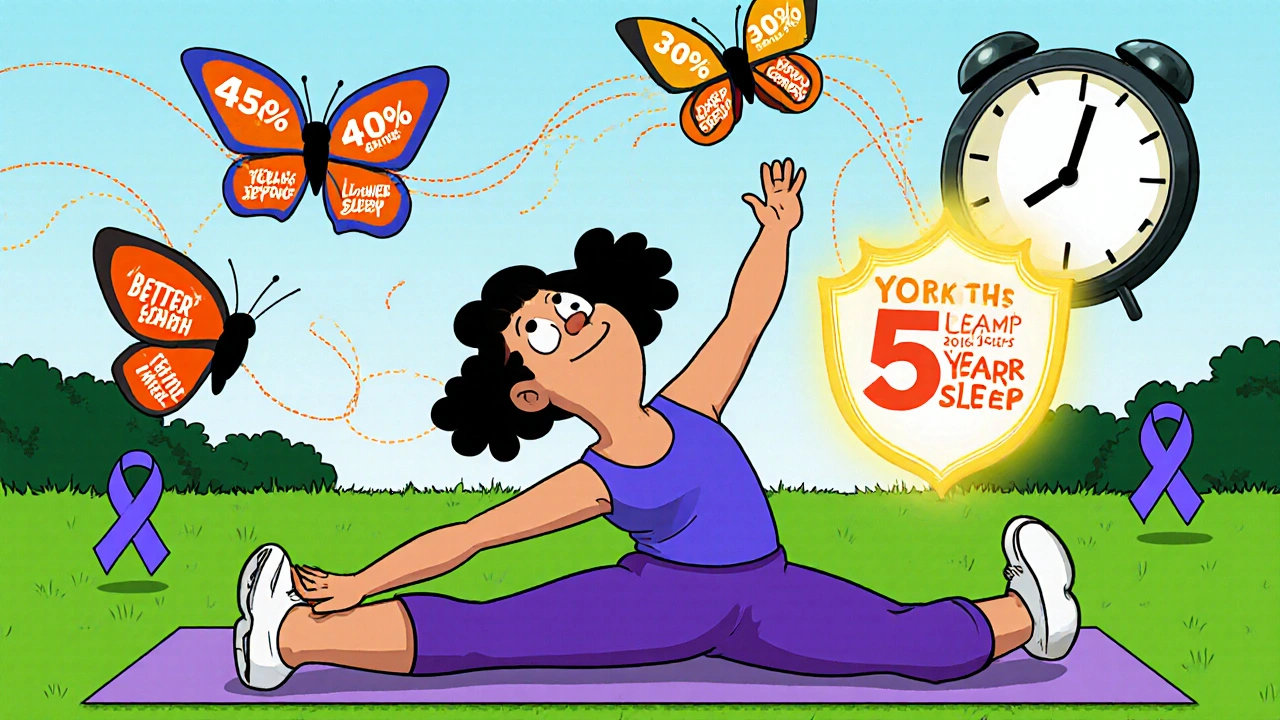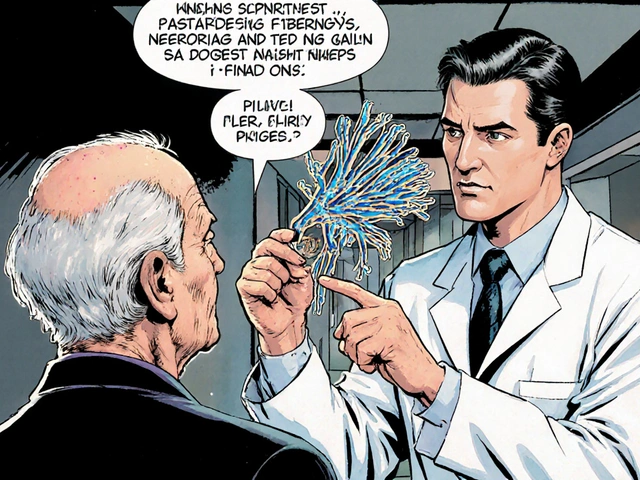Living beyond cancer doesn’t mean the fight is over. For millions of people, the real challenge begins after treatment ends. Fatigue that won’t quit, memory fog that makes simple tasks feel impossible, joint pain from treatments that happened years ago, or the constant fear that cancer might come back - these aren’t rare side effects. They’re the daily reality for most cancer survivors. And yet, too many are left to figure it out alone.
What Survivorship Really Means
Cancer survivorship isn’t just about being alive after diagnosis. It’s the ongoing journey of managing the physical, emotional, and financial fallout that lingers long after the last chemo session or radiation treatment. The term gained formal recognition in 2006 when the Institute of Medicine published a landmark report that shifted the focus from cure to care - from ending cancer to helping people live well after it. Today, over 16.9 million people in the U.S. are cancer survivors, and that number is expected to hit 22.2 million by 2030. Most of them didn’t get a clear roadmap for what comes next. Many assume that once treatment ends, their oncologist will keep watching over them. But oncologists are trained to treat cancer, not to manage heart damage from chemotherapy, thyroid issues from radiation, or depression that shows up five years later.The Hidden Costs of Treatment
Chemotherapy and radiation don’t just kill cancer cells. They damage healthy tissue too. The effects can show up months or even decades later.- Women treated with anthracyclines for breast cancer have a 15-20% risk of developing heart problems - sometimes years after treatment. Regular cardiac checkups every 6 to 12 months are critical.
- Men and women who had chest radiation for Hodgkin lymphoma face a 30% lifetime risk of developing breast cancer. Annual mammograms and MRIs starting 8 years after treatment are standard.
- Chemotherapy can cause early menopause, infertility, hearing loss, nerve damage, and even memory problems that feel like early dementia.
- Radiation to the head and neck can lead to dry mouth, tooth decay, and jawbone damage - issues that dental checkups alone won’t catch.
- Both treatments increase the risk of osteoporosis, especially if hormonal therapy was part of the plan. Bone density scans are often overlooked.
Recurrence: Fear, Facts, and Monitoring
The fear of cancer coming back is one of the most persistent emotional burdens survivors carry. It’s normal. But it shouldn’t control your life. The truth? Most cancers don’t return. For many types - like early-stage breast or colon cancer - the risk drops sharply after five years. But for others, like ovarian or lung cancer, the threat lingers longer. The key is knowing your risk level. The American Society of Clinical Oncology now recommends a risk-stratified approach:- High-risk survivors (those with aggressive treatments or genetic mutations) need checkups every 3-6 months.
- Moderate-risk survivors should see a specialist once a year.
- Low-risk survivors can often be managed by their primary care doctor, with oncology input only if needed.
The Survivorship Care Plan: Your Lifeline
A survivorship care plan is a written document that summarizes your treatment and outlines your future health needs. It should include:- Details of every treatment: drug names, doses, radiation fields, surgery dates
- List of possible late effects based on your treatment
- Recommended screening schedule for recurrence and new cancers
- Guidance on managing ongoing symptoms: pain, fatigue, anxiety, sexual health
- Who to contact if problems arise - and when to call your oncologist vs. your primary care provider
Who Should Be in Charge of Your Care?
Most survivors have a primary care provider (PCP) - a family doctor or internist. And here’s the truth: your PCP knows your body better than your oncologist does. In fact, 63% of older survivors die from causes other than cancer - heart disease, stroke, diabetes. That’s why your PCP should be part of your care team. But here’s the problem: 65% of survivors say their oncologist and PCP don’t communicate well. Records get lost. Test results don’t get shared. Medications aren’t reviewed together. The solution? Take charge. Bring your survivorship care plan to your PCP. Ask your oncologist to send a copy. Make sure your PCP knows:- What treatments you had
- What to watch for
- When to refer you back to oncology

Rebuilding Your Life: Beyond Medicine
Survivorship isn’t just about physical health. It’s about your mind, your relationships, your job, your finances.- 68% of survivors say cancer made it harder to work - whether from fatigue, brain fog, or discrimination.
- 73% face financial stress - from medical bills, lost income, or insurance denials.
- 57% report changes in relationships - with partners, kids, friends.
- 49% say their self-esteem took a hit.
What You Can Do Today
You don’t have to wait for your doctor to fix everything. Here’s what you can do right now:- Get your treatment summary. If you don’t have it, call your oncology clinic. Ask for a copy of your pathology reports, chemo drugs, radiation fields, and surgery details.
- Ask for a survivorship care plan. If they don’t offer one, request it. You’re entitled to it.
- Share it with your primary care doctor. Schedule a visit just to go over it. Bring a list of your symptoms - even the small ones.
- Start moving. Walk 20 minutes a day. Stretch. Take the stairs. Movement is medicine.
- Track your symptoms. Keep a notebook: fatigue levels, pain, mood, sleep. Bring it to appointments.
- Find support. Whether it’s a support group, a therapist, or a survivorship program - don’t go it alone.
What’s Next for Survivorship Care?
The system is improving. Telehealth survivorship clinics are growing - Mayo Clinic’s virtual program had 75% satisfaction rates. Precision survivorship is on the horizon: using your genetics, treatment history, and lifestyle to predict your personal risks and tailor your follow-up. But progress depends on you. If you’re a survivor, speak up. Ask for your plan. Demand better coordination. Share your story. If you’re a provider, learn about late effects. Talk to your patients about life after cancer. The goal isn’t just to survive cancer. It’s to live - fully, healthily, and without fear - long after it’s gone.How often should I be screened for cancer recurrence?
It depends on your cancer type, treatment, and risk level. High-risk survivors (like those with aggressive tumors or genetic mutations) may need checkups every 3-6 months. Moderate-risk survivors typically need annual visits with a specialist. Low-risk survivors can often be monitored by their primary care doctor with occasional oncology input. Always follow your personalized survivorship care plan - not general guidelines.
Can my primary care doctor manage my survivorship care?
Yes - and they should. Most survivors eventually see their primary care provider for routine health needs. The key is communication. Your oncologist must send your treatment summary and care plan to your PCP. Your PCP needs to know what late effects to watch for and when to refer you back. Shared care models reduce duplicate tests and improve outcomes.
What are the most common late effects of chemotherapy?
Common late effects include heart damage (especially from anthracyclines), nerve damage causing numbness or pain, early menopause or infertility, hearing loss, memory issues (sometimes called chemo brain), lung damage, osteoporosis, and increased risk of other cancers. The risk varies by drug and dose. Always review your specific treatment history with your doctor.
Is it normal to feel anxious years after treatment?
Yes. Anxiety, fear of recurrence, and depression are common long after treatment ends. These aren’t signs of weakness - they’re normal responses to a life-changing experience. Counseling, support groups, mindfulness, and sometimes medication can help. Don’t wait until it feels overwhelming - reach out early.
How can I improve my energy levels after cancer?
Fatigue is one of the most persistent side effects. The best solution? Regular physical activity. Walking 150 minutes a week can reduce fatigue by 40-50%. Also prioritize sleep, manage stress with relaxation techniques, limit alcohol, and eat balanced meals. If fatigue is severe or sudden, talk to your doctor - it could signal an underlying issue like anemia, thyroid problems, or depression.
Do I need to keep my treatment records?
Absolutely. Survivors who keep detailed records - including drug names, doses, radiation fields, and surgery dates - are 87% more likely to receive coordinated care. Store them digitally and physically. Bring them to every new doctor, even if they’re not an oncologist. This information saves lives.
Are there programs that help with the financial impact of survivorship?
Yes. Many cancer centers offer financial counseling to help with insurance appeals, billing disputes, and medication costs. Programs like those at the Lurie Cancer Center help 92% of patients resolve financial barriers within 30 days. Nonprofits like the American Cancer Society and Livestrong also offer grants and resources. Don’t suffer in silence - ask for help.






Sam Jepsen
November 24, 2025 AT 06:47Just wanted to say this post hit home. I’m 7 years out from lymphoma and still deal with brain fog that makes me forget where I put my keys or what I was saying mid-sentence. No one talks about how exhausting it is to pretend you’re fine when you’re not. But honestly? I started walking 30 mins a day and it changed everything. Not cured, but I’m living again.
Keep sharing this stuff. People need to know they’re not alone.
Yvonne Franklin
November 25, 2025 AT 12:22Get your care plan. Tell your PCP. Do it now. No excuses.
Mark Williams
November 27, 2025 AT 01:41From a clinical perspective, the data on late-onset cardiotoxicity from anthracyclines is robust, with LVEF decline detectable as early as 12–24 months post-treatment. Yet, only 38% of primary care providers routinely order echocardiograms in survivors without symptoms. We’re missing a massive window for early intervention. The ASCO guidelines are clear but underimplemented. We need standardized EHR alerts for oncology survivors - not just passive PDFs buried in portals.
Also, chemo brain isn’t just anecdotal. fMRI studies show reduced hippocampal volume and altered default mode network connectivity. Cognitive rehab should be reimbursed like PT.
Ravi Kumar Gupta
November 27, 2025 AT 14:12In India, we don’t even have access to basic survivorship care. My sister finished chemo in Mumbai and was told, 'You’re cured, go home.' No plan. No follow-up. No one asked if she could sleep or if her joints hurt. We’re lucky if we get a pill. But I read this and cried - because I know if she had this, she wouldn’t have died from heart failure two years later. Please, someone in the West - don’t take this for granted. Share this. Translate it. Send it to every survivor you know.
Survival isn’t luck. It’s a right.
james lucas
November 28, 2025 AT 03:04man i just got done with my last chemo session last year and honestly i had no clue any of this stuff was a thing. i thought once the needles stopped i was good to go. turns out i got like 3 different late side effects going on and my doc never mentioned any of it. i just thought i was getting old or lazy. now i’ve got my care plan printed out and i’m taking it to my family doc next week. also started walking with my dog every morning - 15 mins at first, now 30. i feel like a different person. thanks for this post, seriously.
also i misspelled like half the words in this comment but you get the point lol
Miruna Alexandru
November 29, 2025 AT 05:42It’s fascinating how the medical-industrial complex has co-opted the term 'survivorship' to absolve itself of systemic failure. You’re told to 'take charge' - as if the burden of navigating fragmented care, inaccessible records, and insurance bureaucracy should fall on someone who just survived chemotherapy. The real failure isn’t the lack of care plans - it’s the refusal to fund integrated, multidisciplinary survivorship clinics as standard of care. This post reads like a self-help pamphlet disguised as medical guidance. Empowerment is not a substitute for equity.
Robin Johnson
November 30, 2025 AT 02:57Yvonne’s comment is spot on. Get the plan. Tell your PCP. Do it today.
I’m a survivor. I’ve been through it. I’ve watched friends fall through the cracks because no one told them what to do next. The system isn’t built for us. So we have to build our own safety net. Write down every drug. Keep the scans. Ask for the plan. Send it to your doctor. Don’t wait for permission. You’ve already survived cancer. This is the easy part.
Latonya Elarms-Radford
December 1, 2025 AT 01:36There’s something profoundly tragic about how we’ve turned the sacred, soul-shattering journey of surviving cancer into a checklist. 'Get your care plan.' 'Walk 150 minutes.' 'Track your symptoms.' We’ve sanitized the horror of it all into bullet points on a wellness app. The fear of recurrence isn’t a medical condition to be managed - it’s the echo of mortality, the whisper that says, 'You were lucky. But luck doesn’t last.'
And yet - we still cling to these lists. Because to sit with the silence, the uncertainty, the grief that never leaves - that’s too much. So we turn to protocols. To spreadsheets. To walking. To exercise. Anything to feel like we’re still in control.
But control was never the point. Survival was. And sometimes, just breathing is enough.
Nikhil Chaurasia
December 2, 2025 AT 08:29I come from a culture where we don’t talk about illness too loudly - it brings bad luck. But after reading this, I finally told my mother about my fatigue and joint pain. She cried. Said she never knew it was part of treatment. We’re going to the clinic next week. I didn’t know asking for help was allowed. Thank you for giving me the words.
Survivorship isn’t loud. It’s quiet. And sometimes, that’s enough.
Shawn Daughhetee
December 2, 2025 AT 17:29just started walking with my buddy every morning and it’s the only thing that makes me feel like me again. not cured but not broken either. also finally got my care plan from my oncologist after begging for 6 months. it’s like 12 pages but i keep it in my wallet. my pcp said he’s never seen one before but he’s gonna learn. thanks for this post. real talk.